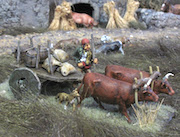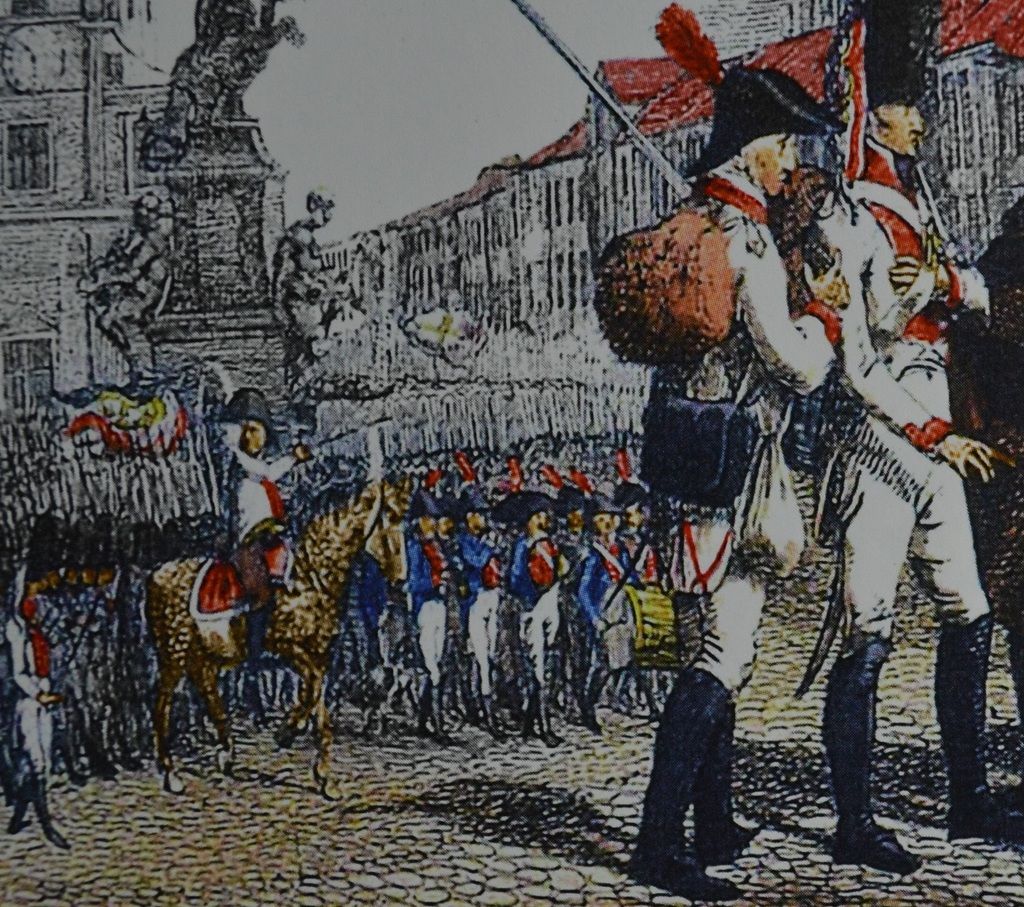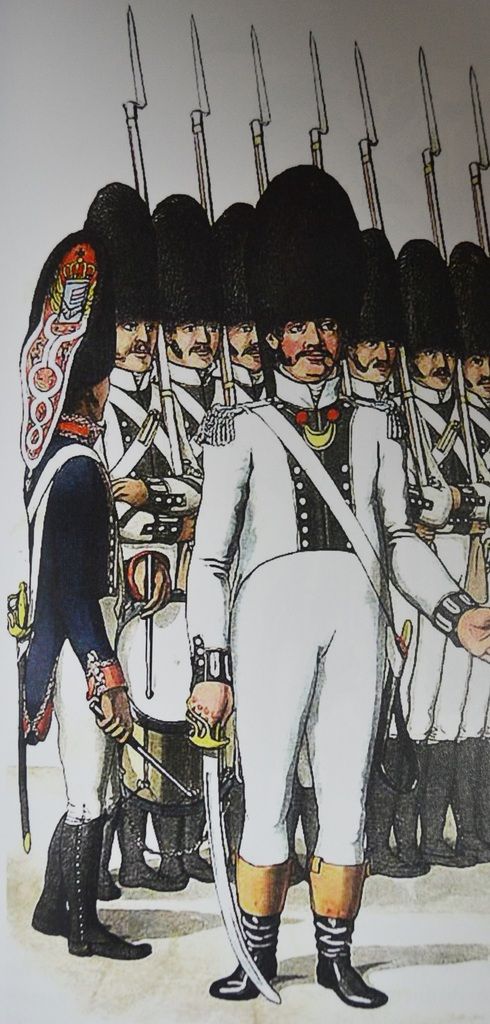Late to this thread (new to the forum) but I very much enjoyed seeing these. What a beautiful and impressive first foray into Napoleonics!
As I am deep into painting a Spanish army, mostly HaT figures as well, I was curious about the red flag staff and reversed colours on the drummer. I hadn't found any reference on either but could easily be convinced to go back and repaint my own. Anything on this that you might point me to?
Looking forward to seeing your next Bailén instalment. I found the Irlanda regiment especially nice to paint. I think the Walloon Guards and, of course, the Swiss (same uniform, both sides!) were present as well. Lots of variety, as always with the Spanish.
Gallery
Ordenes Militares Regiment, 1808
30 posts
• Page 2 of 2 • 1, 2
-

Bill Slavin
 Supporting Member (Bronze)
Supporting Member (Bronze)- Posts: 1338
- Member since:
24 Oct 2016, 14:55
Bill - Many thanks.
I have certainly seen illustrations of flag staffs in red (not necessarily red-faced regiments) and, as I had no specific information re Ordenes Militares, I used red as it 'themed' well with the cockades and plumes.
The drummers are intended to be in Royal livery, rather than reverse colours, and I persuaded myself of the appropriateness of this having read Cronin & Summerfield last year and looked at reproductions of drummers depicted by Suhr. Of course, I have since seen a number of modern illustrations of drummers in white coats. If in doubt, err on the side of what you like!
I have certainly seen illustrations of flag staffs in red (not necessarily red-faced regiments) and, as I had no specific information re Ordenes Militares, I used red as it 'themed' well with the cockades and plumes.
The drummers are intended to be in Royal livery, rather than reverse colours, and I persuaded myself of the appropriateness of this having read Cronin & Summerfield last year and looked at reproductions of drummers depicted by Suhr. Of course, I have since seen a number of modern illustrations of drummers in white coats. If in doubt, err on the side of what you like!
-

Edwardian
- Posts: 74
- Member since:
11 Feb 2017, 15:49
-

Bill Slavin
 Supporting Member (Bronze)
Supporting Member (Bronze)- Posts: 1338
- Member since:
24 Oct 2016, 14:55
Spanish Drummers.
Spanish Infantry of the Early Peninsular War, Cronin & Summerfield, p72, states that, from the reign of Carlos III, all drummers had blue coats and red facings, and cites a private communication with Luis Sorando Muzas in 2013 as authority for this statement.
Three sources appear to record these blue coated drummers with the Romana Division in Hamburg in 1807; Augsburger, Suhr and Weber. It might be objected that many of these men wore the 1802 blue uniform and that blue coated drummers were part of the 1802 uniform. Clearly, however, the drummers do not match the 1802 uniform, which was blue with black facings piped red for all regiments. The drummers' uniform, in contrast, had red facings with red and white lace borders.
Persuasively, in my view, blue coated drummers and musicians are depicted alongside the white coated infantry regiments in Hamburg. These white uniforms had to be made in Paris. I can think of no reason why drummers would not have had replacement coats in white had this been the regulation.
The use of this blue uniform for drummers is reminiscent of the Bourbon livery of French drummers in white-coated regiments of the Eighteenth Century. That is how I interpret it.
So, you pays your money and takes your choice, but I have plumped for blue coated drummers faced red, regardless of regiment. I shall also render drummers in the Provincial Militia thus.
Anyway, below is an illustration of the white, faced red, Guadalajara regiment, and the white, faced black, Zamora regiment. Both are Hamburg, 1807.


Spanish Infantry of the Early Peninsular War, Cronin & Summerfield, p72, states that, from the reign of Carlos III, all drummers had blue coats and red facings, and cites a private communication with Luis Sorando Muzas in 2013 as authority for this statement.
Three sources appear to record these blue coated drummers with the Romana Division in Hamburg in 1807; Augsburger, Suhr and Weber. It might be objected that many of these men wore the 1802 blue uniform and that blue coated drummers were part of the 1802 uniform. Clearly, however, the drummers do not match the 1802 uniform, which was blue with black facings piped red for all regiments. The drummers' uniform, in contrast, had red facings with red and white lace borders.
Persuasively, in my view, blue coated drummers and musicians are depicted alongside the white coated infantry regiments in Hamburg. These white uniforms had to be made in Paris. I can think of no reason why drummers would not have had replacement coats in white had this been the regulation.
The use of this blue uniform for drummers is reminiscent of the Bourbon livery of French drummers in white-coated regiments of the Eighteenth Century. That is how I interpret it.
So, you pays your money and takes your choice, but I have plumped for blue coated drummers faced red, regardless of regiment. I shall also render drummers in the Provincial Militia thus.
Anyway, below is an illustration of the white, faced red, Guadalajara regiment, and the white, faced black, Zamora regiment. Both are Hamburg, 1807.


-

Edwardian
- Posts: 74
- Member since:
11 Feb 2017, 15:49
I'm sold. (Busily getting out paints - again!)
Interestingly, I just noticed on Steven's Bagalan site (Peninsular War Painting Guide : Spanish Infantry) that he has a note that the Aragon (light infantry) drummer has red coat with blue facings, white piping - which would make sense as it would contrast with the blue coat that was the light infantry's standard colour.
Interestingly, I just noticed on Steven's Bagalan site (Peninsular War Painting Guide : Spanish Infantry) that he has a note that the Aragon (light infantry) drummer has red coat with blue facings, white piping - which would make sense as it would contrast with the blue coat that was the light infantry's standard colour.
-

Bill Slavin
 Supporting Member (Bronze)
Supporting Member (Bronze)- Posts: 1338
- Member since:
24 Oct 2016, 14:55
Bill Slavin wrote:I'm sold. (Busily getting out paints - again!)
Interestingly, I just noticed on Steven's Bagalan site (Peninsular War Painting Guide : Spanish Infantry) that he has a note that the Aragon (light infantry) drummer has red coat with blue facings, white piping - which would make sense as it would contrast with the blue coat that was the light infantry's standard colour.
I found this guide. It has a lot of interesting information, but included some content that I found quite odd:
1802 Regulation: In use post 1808 by some Provincial units and some volunteer units. Long tailed white coat with lapels squared and closed to the waist, plus bicorn.
1806 Regulation: In use by the regulars in 1808 but quickly supplemented by ad hoc uniforms, and largely superseded by British uniform from 1812. Short tailed white coat with bicorn.
The 1802 uniform was blue, faced black and piped red for all line regiments. This had "squared and closed" lapels and short tails. It was the 1797 uniform that featured long-tailed white coats for line infantry, but not with the lapels "squared and closed". In 1808, some units still appear in the 1797 uniform, including line regiments, Swiss regiments and Provincial Grenadiers. A number of line regiments seem to have worn the blue 1802 uniform in 1808.
The 1805 uniform returned to white for line infantry.
There is also a reference in this guide to Swiss regiments in red coats, though later this is correctly given as blue.
There is no mention of the Provincial Militia provisional brown uniform, which seems to have been the most common in 1808, as the white uniform does not seem to have been received by many battalions at all. The older blue faced red uniform is not mentioned either. One or two units seem to have had this, though some seem to have worn out these uniforms without receiving replacements.
I think the advantage offered by Cronin & Summerfield is that they have collated more recent scholarship including that of the leading Spanish authorities, whereas the Bagalan site appears to base its information on Funcken (1973), Haythornthwaite (1995), Sapherson (1991) (the latter is unfamiliar to me).
-

Edwardian
- Posts: 74
- Member since:
11 Feb 2017, 15:49
Help keep the forum online!
or become a supporting member
I actually painted all my Swiss in red before realizing my error! So you're right, double check your sources. I don't have the Cronin and Summerfield book but it appears that I can pick it up used for $485 on Amazon!
-

Bill Slavin
 Supporting Member (Bronze)
Supporting Member (Bronze)- Posts: 1338
- Member since:
24 Oct 2016, 14:55
Bill Slavin wrote:I actually painted all my Swiss in red before realizing my error! So you're right, double check your sources. I don't have the Cronin and Summerfield book but it appears that I can pick it up used for $485 on Amazon!
Not only
Cronin and S. Summerfield, Spanish Infantry of the Early Peninsular War: Uniforms, Organization and Equipment of the Line Infantry and Militia (Ken Trotman Publishing: Godmanchester, 2014), 175, ISBN: 978-1-907417-42-9.
but also
Cronin and S. Summerfield, Cavalry of the Early Peninsular War: uniforms, Organization and Equipment of the Line Cavalry, Guard and Artillery (Ken Trotman Publishing: Godmanchester, 2016), 192, ISBN: 978-1-907417-74-0.
Both appear to be available from the publisher, Ken Trotman: http://kentrotman.co.uk/new/spanish-infantry-of-the-early-peninsular-war-uniforms-organisation-and-equipment-of-the-line-and-militia/
I purchased the Infantry volume a year or so ago from the one of the co-author's business (Gringos40s) and have just acquired the Cavalry volume from Kent Trotman's website.
The pathetic state of the Pound is your friend here, as the £35 price per volume is probably no more than US$42 right now.
There is a review on the link I posted, and it starts with a very revealing statistic, which is perhaps worth quoting:
Let us begin with an interesting statistic. Thanks to close analysis of the highly detailed casualty lists drawn up some 100 years ago by the French historian, Martinien (casualty lists, be it said, that are generally agreed to be extremely reliable), it has been shown that 34,000 French soldiers were killed in action in the Peninsular War. If asked who was responsible for these deaths, most British observers would probably come down without hesitation on the side of either the Anglo-Portuguese army of the Duke of Wellington or the famous Spanish guerrillas. Yet the reality is very different. Thus, actions in which British and/or Portuguese troops participated accounted for just thirty-one per cent of the total, and actions involving irregular forces alone an even more surprising nineteen per cent. In short, a minimum of fifty per cent of French losses were caused by representatives of the Spanish regular army, whilst inclusion of French soldiers killed by Spaniards in such actions as Talavera, Albuera and Vitoria would probably raise this total by one or two percentage points.
-
Bill Slavin likes this post. •
- Reply
-

Edwardian
- Posts: 74
- Member since:
11 Feb 2017, 15:49
Apologies, Bill, as I looked up US, not Canadian $, so yours for about CAD57.43!
I should have mentioned that the infantry book contains not merely the colour schematics for the 1805 white uniforms for each regiment, but a table setting out what is known of uniform changes and a colour schematic showing the uniforms now believed to have been worn as at April 1808.
So, of the 35 line infantry regiments, 12 are shown as still wearing the blue 1802 uniform and 2 or 3 (a discrepancy between the table and the schematic!) still in the white 1797 uniform. This is based upon research by Sorando Muzàs in 2012.
I should have mentioned that the infantry book contains not merely the colour schematics for the 1805 white uniforms for each regiment, but a table setting out what is known of uniform changes and a colour schematic showing the uniforms now believed to have been worn as at April 1808.
So, of the 35 line infantry regiments, 12 are shown as still wearing the blue 1802 uniform and 2 or 3 (a discrepancy between the table and the schematic!) still in the white 1797 uniform. This is based upon research by Sorando Muzàs in 2012.
-

Edwardian
- Posts: 74
- Member since:
11 Feb 2017, 15:49
Back to this post!
Edwardian, I'm in the process of painting somes Ordenes
Militares and was wondering about the embroidered banners ( sacks, flammes?) on your grenadiers. I've been unsuccesful in finding reference for these for this unit.
Any thoughts? Did you go with the blue because that was the tradition - to match the piping? Or did you have some specific reference?
Edwardian, I'm in the process of painting somes Ordenes
Militares and was wondering about the embroidered banners ( sacks, flammes?) on your grenadiers. I've been unsuccesful in finding reference for these for this unit.
Any thoughts? Did you go with the blue because that was the tradition - to match the piping? Or did you have some specific reference?
-

Bill Slavin
 Supporting Member (Bronze)
Supporting Member (Bronze)- Posts: 1338
- Member since:
24 Oct 2016, 14:55
30 posts
• Page 2 of 2 • 1, 2
